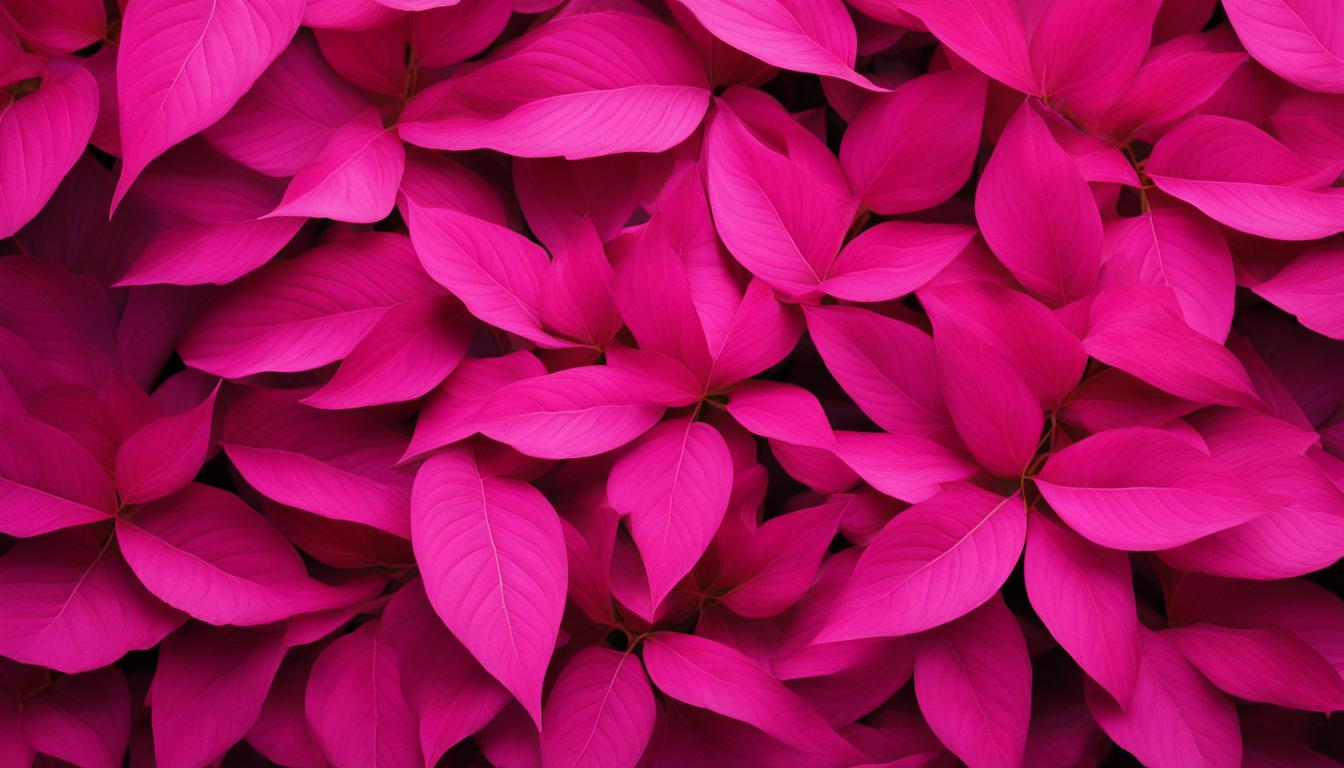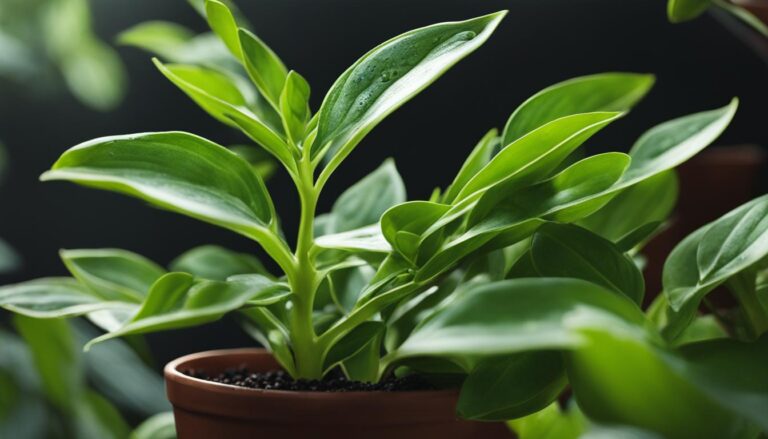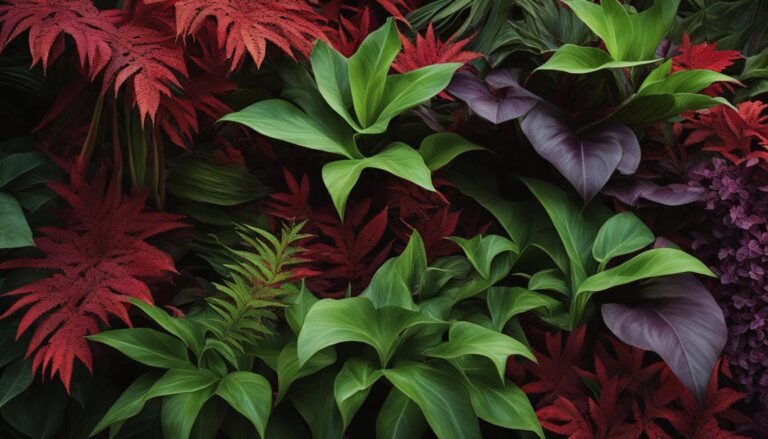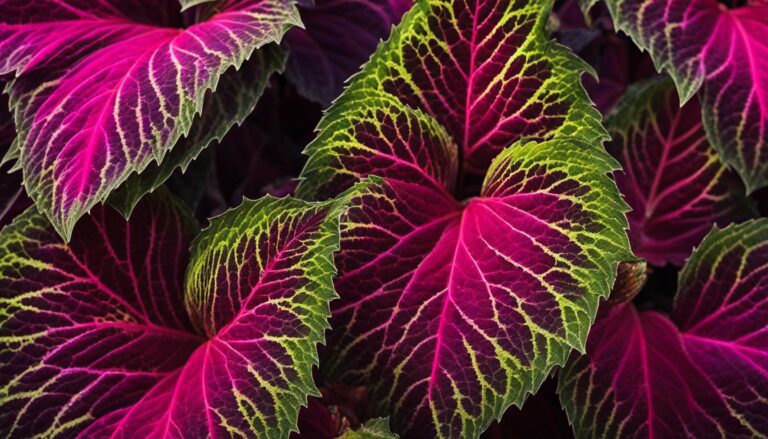
Pink foliage plants are a delightful and captivating addition to any home or garden. With their unique blend of green and pink leaves, these plants bring a burst of color that lasts longer than traditional pink flowers.
They come in a variety of shapes and sizes, ranging from dramatic large foliage to smaller, more compact options. Whether you want to enhance your indoor space or add a touch of color to your outdoor garden, there is an abundance of stunning pink-leaved plants to choose from.
Key Takeaways:
- Pink foliage plants offer vibrant and long-lasting color for your home or garden.
- There are numerous pink houseplants available, such as the Nerve Plant, Dracaena Marginata, Chinese Evergreens, and Calathea.
- Outdoor pink plants include Pink Muhly Grass, Japanese Maple trees, Caladiums, and Cordyline plants.
- Adding pink foliage plants can brighten up your indoor space or add a pop of color to your outdoor garden.
- Explore the wide variety of pink foliage plants and choose the ones that best suit your preferences and needs.
Pink Houseplants for Indoor Gardens
If you want to add a touch of pink to your indoor garden, there are several pink houseplants that are perfect for this. These plants not only bring vibrant color but also add a fresh and lively atmosphere to your indoor space. Here are a few pink houseplants that you can consider:
- Nerve Plant: Also known as the mosaic plant, the Nerve Plant features mosaiced or stained-glass window-like leaves with white or deep pink veins. It’s a beautiful and decorative addition to any indoor garden.
- Dracaena Marginata: This tropical-looking plant has long, narrow leaves with pink hues. It can add height and drama to your indoor space, reaching up to eight feet tall.
- Chinese Evergreens: With glossy leaves adorned with pink patterns, Chinese Evergreens are not only visually appealing but also low-maintenance. They are perfect for those who are new to indoor gardening.
- Calathea: Also known as the zebra plant or prayer plant, Calathea has delicate, showy leaf patterns with pink accents. It’s a stunning plant that can bring a touch of elegance to any indoor garden.
These are just a few examples of the many pink houseplants available to brighten up your indoor space. Each of these plants has its own unique characteristics and care requirements, so make sure to choose the one that best suits your preferences and indoor growing conditions.
Pink Houseplants Comparison
| Plant Name | Characteristics | Care Level | Size |
|---|---|---|---|
| Nerve Plant | Mosaiced or stained-glass window-like leaves with white or deep pink veins | Moderate | Small |
| Dracaena Marginata | Long, narrow leaves with pink hues | Easy | Tall (up to eight feet) |
| Chinese Evergreens | Glossy leaves with pink patterns | Low | Varies |
| Calathea | Delicate, showy leaf patterns with pink accents | Moderate | Medium |
As you can see, each pink houseplant has its own unique characteristics and care requirements. Consider factors such as the amount of light and humidity in your indoor space, as well as your own gardening experience, when choosing the perfect pink houseplant for your indoor garden.
Pink Plants for Outdoor Gardens
If you’re looking to add a touch of pink to your outdoor garden, there are plenty of options to choose from. Pink foliage plants can bring a vibrant and unique element to your outdoor space, creating a visual feast for the eyes.
One stunning option is the Pink Muhly Grass, known for its fluffy pink plumes that sway gracefully in the breeze. This ornamental grass not only adds a pop of color but also creates a whimsical and romantic atmosphere in your garden.
For a more delicate and elegant touch, consider Japanese Maple trees. These trees feature purple-pink leaves that symbolize grace and beauty. Whether planted as a standalone tree or in a group, they create a stunning focal point in any garden.
If you have shady spots in your garden, Caladiums are an excellent choice. With their heart-shaped leaves and pink centers or veining, they bring a splash of color to those darker areas. Plus, they are well-suited to hot and humid climates, making them easy to care for.
Lastly, Cordyline plants offer a versatile option for both outdoor and indoor gardens. With their variegated leaves and pink or white edges, they add a touch of elegance and sophistication to any space. Whether planted in a pot or directly in your garden, they are sure to make a statement.
After reading this, check out our other articles on:
- Grow Lush Scenery with a Tropical Foliage Plant Today!
- Exploring the World of Ferns: Identifying the Different Types
FAQ
Are pink foliage plants difficult to care for?
Pink foliage plants vary in their care requirements, but many are relatively low-maintenance. It’s important to research the specific plant’s needs and provide it with the proper amount of light, water, and fertilization.
Can pink houseplants be grown in low light conditions?
Yes, some pink houseplants, such as Chinese Evergreens and Calatheas, can tolerate lower light conditions. However, it’s important to ensure they still receive some indirect light to keep their colors vibrant.
Can pink plants be grown outdoors in colder climates?
Some pink plants, like Japanese Maple trees, can withstand colder climates. However, it’s essential to choose pink plants that are suitable for your specific climate and provide them with proper winter protection if necessary.
Do pink foliage plants require any special soil or fertilizers?
While pink foliage plants have their individual preferences, most will thrive in well-draining soil and benefit from regular fertilization during the growing season. It’s a good idea to use a balanced fertilizer and follow the specific instructions for each plant.
Can pink houseplants be propagated easily?
Yes, many pink houseplants can be propagated through methods such as stem or leaf cuttings. However, it’s essential to follow the proper techniques and provide the right conditions for successful propagation.
Can pink foliage plants be toxic to pets?
Some pink foliage plants can be toxic to pets if ingested. It’s important to research each plant’s toxicity level and take necessary precautions, such as keeping them out of reach or opting for pet-safe alternatives.







2 Comments
Comments are closed.